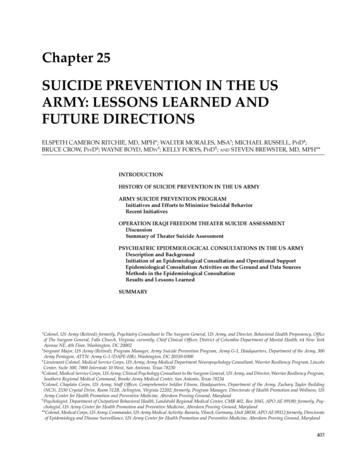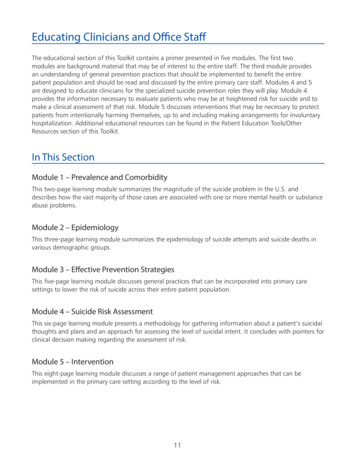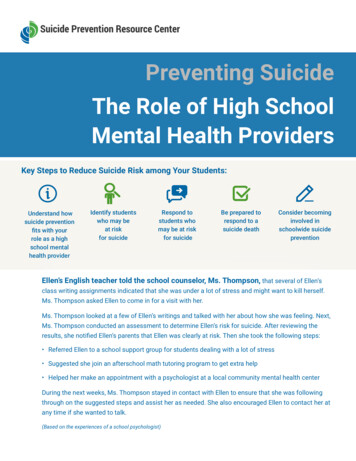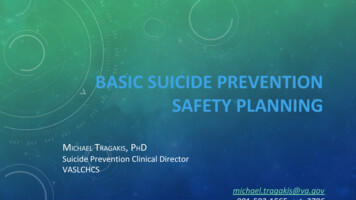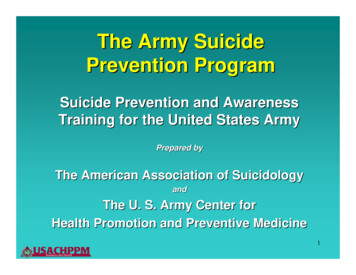
Transcription
The Army SuicidePrevention ProgramSuicide Prevention and AwarenessTraining for the United States ArmyPrepared byThe American Association of SuicidologyandThe U. S. Army Center forHealth Promotion and Preventive Medicine1
Our MissionMinimize Army suicidalbehavior by encouraginghelp-seeking and providing“Buddy Care.”The Army Suicide Prevention Program is based on trained andready personnel at all levels. The mission of all personnel is toencourage help-seeking behaviors and to attain proficiency inthe “Buddy Care” principles in this training module.2
Levels of TrainingMental HealthCare ProvidersUnit Ministry TeamsInstallation GatekeepersAll NCO’s and OfficersHIGHSPECIFICITYIndividualSuicidal RiskAwareness isthe foundationfor allsubsequentlevels ofSuicidePreventionTraining.LOWBattle Buddies / Soldiers3
Support: Learning Objectives1.Describe primary, secondary, andtertiary suicide prevention2.Identify personal andenvironmental protective factors3.Know information about localsupport resources and programs4
Support: Learning Objectives4.Promote cohesion and a senseof belonging5.Encourage help seekingbehavior5
Army Suicide Preventionand Awareness TrainingMental Health CareProvidersTERTIARYRecognizing and treatingpsychiatric disorders thatresult in acute suicidalBehaviors.SECONDARYUnit Ministry TeamsInstallationGatekeepersAll NCO’s and OfficersPRIMARYAnticipating potentialtimes of crisis andstructuring pre-emptivesupport systems.Battle Buddies/SoldiersRecognizing theobvious signsand symptoms ofdistress/crisisand potentialemotional/mentaldisorder whileproviding caringsupport andneededInterventions.Soldier/Family Support Systemsand Well-being Screening6
)rimary(PSecure(Terti ary)Secondary)Spot(ScreenStructure7
Personal Protective Factors Easy temperamentPrevious experience with self-mastery,problem solving, and crisis resolution Optimistic outlook Social/emotional competence High self esteem, self worth8
Personal Protective Factors Decision making, problem solving skills Sense of personal control, self efficacy Sense of belonging to a group and/ororganization High and realistic expectations High spiritual resiliency9
Environmental Protective Factors Strong family relationships Models of healthy coping Encouragement of participation Opportunities to make significantcontributions10
Environmental Protective Factors Available social supports Available helping resources Healthy spiritual/religious affiliation Cultural and religious beliefs againstsuicide and in support of selfpreservation11
SupportThe Reasons for Living Inventory,Linehan, Goodstein, Nielsen & Chiles(1983) Spirituality and ResilienceAssessment Packet, Version 4.2,Kass (2000) 12
Connections save lives. Spiritual connectedness Unit cohesiveness13
Seeking help is a sign ofeffectively dealing withproblems, and of strengthrather than weakness.14
A good leader does notexpose those under his/hercommand to unnecessary risk.15
SupportPromote a norm of mutual BuddyCare among all military personnel:“We are our brother’s keepers!” Pay attention to warning signs andrespond to those who need help 16
Support Pay close attention to the personalneeds of your people and be on thelookout for signs of stress Communicate in your words andactions that it is not only acceptable,but a sign of strength, to recognize lifeproblems and get help to deal withthem constructively17
Support Support and protect to the fullestextent possible those courageouspeople who seek help early, before acrisis develops18
Support Create a responsive, caring, andresponsible environment whereindividuals are motivated to seekhelp with personal struggles withoutfear of being singled out19
Support Foster a social climate in your unitthat communicates to everyone,“You belong here.”20
Our MissionMinimize Army suicidalbehavior by encouraginghelp-seeking and providing“Buddy Care.”The Army Suicide Prevention Program is based on trained andready personnel at all levels. The mission of all personnel is toencourage help-seeking behaviors and to attain proficiency inthe “Buddy Care” principles in this training module.21
Screen: Learning Objectives Understand the benefits of gatedscreening Be informed about the confidentialityof screening results Be informed about secondaryscreening instruments22
Screen The Army Structure makesscreening viableScreening must be gatedThe Suicide Prevention StandingCommittee collects and reportsanonymous data23
ScreenGoldberg Well-Being Scale (1972)Please circle the most appropriate response:In the last two weeks have you:Notat allNo morethan usualA little morethan usualA lot morethan usual1Been able to concentrate on whatever you’you’re doing? 12342Lost much sleep over worry?12343Felt that you are playing a useful part in things?12344Felt capable of making decisions about things?12345Felt constantly under strain?12346Felt that you couldn’couldn’t overcome your difficulties?12347Been able to enjoy your normal dayday-toto-day activities? 12348Been able to face up to your problems?12349Been feeling unhappy and depressed?123410 Been losing confidence in yourself?123411 Been thinking of yourself as a useless person?123412 Been feeling reasonably happy, all things considered?123424
Screen GoldbergWell-being Scale informationwill be disclosed only to the individualand will be used only to assess andassist personnel during of times ofdistress. UnitTrends may be reported to theUnit Commander as a gauge of his/herunit well-being.25
Screen Multidimensional Health Profile(MHP) Ruehlman, Lanyon & Karoly Life Stressors and Social ResourcesInventory (LISRES-Adult), Moos26
Gatekeeper Lesson 1All Personnel27
Gatekeeper Lesson 1Learning Objectives1.Understand The Suicide Model.2.Answer general questions about suicide.3.Identify common precipitants of suicide.4.Identify symptoms of depression.5.Identify myths about suicide.6.Identify warning signs of suicide.7.Take appropriate action in response to at-riskindividual.28
Main Points The Suicide Model What is suicide? Why should we know about suicide? Why do people commit suicide? Some stressful situations that cantrigger suicidal feelings in the ArmyWho commits suicide?29
Main Points Special problems that can causesuicidal feelingsMisconceptions about suicide30
Main Points How can you tell if someone isthinking about committing suicide? Common symptoms of depressionand hopelessness31
Main Points Referralprocedures32
The Army Suicide Prevention ModelINDIVIDUALREADINESSNormal LifeStressor orDisorderPREVENTION- Identifying “High Risk” Soldiers- Caring and Proactive Leaders- Encouraging Help Seeking Behavior- Positive Life Coping SkillsAwarenessTrainingCo(Inst ntal lat inion uiStan tyding ofCoCammrittee e)ReferralINTERVENTIONLifeCrisis- Suicide Awareness and Vigilance- Integrated & Synchronized Unit andCommunity-wide support Agencies- Assured Problem ResolutionOutpatient CareSECURESuicidalIdeation- Safeguard- Psychiatric Treatment- Psychiatric AssessmentInpatient CareFollow on CareSuicideBehaviorsDEATHPostvention33
Suicidal Behavior Serious suicidal thoughts or threats Self destructive acts Attempts to harm, but not kill oneself Attempts to commit suicide Completed suicide34
Triggers of Suicidal Behavior A bad evaluation for an enlisted soldier or officer The breakup of a close relationship Drug or alcohol abuse Reunion from a long field training or isolated tour Leaving old friends Being alone with concerns about self or family Financial stressors New military assignments35
Triggers of Suicidal Behavior Recent interpersonal losses Loss of esteem/status Humiliation Rejection (e.g., job, promotion boy/girlfriend) Disciplinary or legal difficulty Suicide of a friend or family member Discharge from treatment or from service Retirement36
“Bimodal” Distribution3530Developing Life Coping Skills- Behavioral Development- Life MentorsEncouraging Helpseeking Behavior- Stigma Reduction- Confidentiality25Facing Major TransitionRelationship Failure20Mood Disorder/15Substance AbuseImpulsivePoor Coping Skills10- Financial, Relationships- Substance Abuse5- Facing UCMJ Action017-1920-24 Numbers based upon U.S. Army CasualtyReports confirmed suicides for active dutyRA, ANG, USAR for CY 9925-29TOTAL30-3435-3940-4445 RATE PER 100K37
Suicide Totals by Force80604020019951996199719981999ANG/USAR SuicideTotals568715RA Suicide Totals7561495758ANG/USAR Suicide TotalsRA Suicide Totals38
Suicide Rate Trends *(Includes USAR/ANG)1716151413121110Bar represents start of previous program outlinedin Chapter 5, AR 600600-63, Army Health Promotion.Promotion.Rates per es 7 “undetermineddeaths”198711.819102191991The civilian rate per100K, demographicallyadjusted for age, genderand race, is 19.14901915.736663In the 1990’s, the Army lost a battalion’s equivalent (800) to suicide39
Gatekeeper Lesson 2Officers and NCOs40
Synchronized Prevention MeasuresLeader InvolvementSupport MeasuresSuicide Prevention StandingCommittee Coordinates Community SupportAgencies Involvement Managesand SynchronizesCommunity Prevention Programs Prescreening ProvidingM.H. Surveillance Psychiatric Care Advises Cdr’s SME for Prevention Training CrossTalks Risk Identification UnitLevel Instruction Counseling/Life Skills Training Encourages Help-seeking Behavior Positive Role Model Principle Advisor to LeadershipBattleBuddiesUnit Ministry TeamsCommunity Support AgenciesHelp-Seeking Behavior Sense of Unit Belonging Positive Role Model Knowledge of Support Agencies Genuine Interest and Concern Risk IdentificationFirst Line Supervisor Encourages IntegratesMental Health Providersfor Unit Level Trainingfor Individual Well-being Confidentiality ResponsibleCompany Commander ResponsibleBn and Bde CommandersSubordinate Units Programs Ensures Active UMT Participation Support Life Skills TrainingInstallation Suicide Prevention Standing Committee Supervises Knowledgeof Support AgenciesInterest and Concern Risk Identification Genuine41
Gatekeeper Lesson 2Learning Objectives1.Inquire about suicide2.Respond to phone callers3.Obtain help for suicidalindividuals42
Responding toStatements or Threats Stay calm Send someone for help Do not leave alone Buy time43
Responding toStatements or Threats Acknowledge Listen Convey44
Responding toStatements or Threats Secure Note the time Take action45
Asking About Suicide Review your evidence Inquire or state about feelings Persist “Sometimes” approach46
Asking About Suicide Ask directly Get help Convey concern47
Gatekeeper Lesson 3Formal Gatekeepers48
Synchronized Prevention MeasuresLeader InvolvementSupport MeasuresSuicide Prevention StandingCommittee Coordinates Community SupportAgencies Involvement Managesand SynchronizesCommunity Prevention Programs Prescreening ProvidingM.H. Surveillance Psychiatric Care Advises Cdr’s SME for Prevention Training CrossTalks Risk Identification UnitLevel Instruction Counseling/Life Skills Training Encourages Help-seeking Behavior Positive Role Model Principle Advisor to LeadershipBattleBuddiesUnit Ministry TeamsCommunity Support AgenciesHelp-Seeking Behavior Sense of Unit Belonging Positive Role Model Knowledge of Support Agencies Genuine Interest and Concern Risk IdentificationFirst Line Supervisor Encourages IntegratesMental Health Providersfor Unit Level Trainingfor Individual Well-being Confidentiality ResponsibleCompany Commander ResponsibleBn and Bde CommandersSubordinate Units Programs Ensures Active UMT Participation Support Life Skills TrainingInstallation Suicide Prevention Standing Committee Supervises Knowledgeof Support AgenciesInterest and Concern Risk Identification Genuine49
Gatekeeper Lesson 3Learning Objectives Identify risk factors for suicide Conduct basic risk assessment50
Risk Assessment Questions1.Have you been thinking of killingyourself?2.What has happened that makes lifenot worth living?3.How will you do it?4.How much do you want to die?51
Risk Assessment Questions5.How much do you want to live?6.How often do you have thesethoughts?7.When you think of suicide, how longdo the thoughts stay with you?8.Have you ever attempted suicide?52
Risk Assessment Questions9.Have you been drinking heavily lately ortaking drugs?10.Has anyone in your family committed orattempted suicide?11.Is there anyone or anything to stopyou?12.On a scale of 1 to 10, what is theprobability that you will kill yourself?53
SecureHealth Care Professionals54
Synchronized Prevention MeasuresLeader InvolvementSupport MeasuresSuicide Prevention StandingCommittee Coordinates Community SupportAgencies Involvement Managesand SynchronizesCommunity Prevention Programs Prescreening ProvidingM.H. Surveillance Psychiatric Care Advises Cdr’s SME for Prevention Training CrossTalks Risk Identification UnitLevel Instruction Counseling/Life Skills Training Encourages Help-seeking Behavior Positive Role Model Principle Advisor to LeadershipBattleBuddiesUnit Ministry TeamsCommunity Support AgenciesHelp-Seeking Behavior Sense of Unit Belonging Positive Role Model Knowledge of Support Agencies Genuine Interest and Concern Risk IdentificationFirst Line Supervisor Encourages IntegratesMental Health Providersfor Unit Level Training Responsible for Individual Well-being ConfidentialityCompany Commander ResponsibleBn and Bde CommandersSubordinate Units Programs Ensures Active UMT Participation Support Life Skills TrainingInstallation Suicide Prevention Standing Committee Supervises Knowledgeof Support AgenciesInterest and Concern Risk Identification Genuine55
Secure: Learning Objectives1.Become knowledgeable aboutArmy suicide policies andprocedures2.Conduct advanced riskassessment56
The Suicide PreventionStanding Committee Sets local policies and procedures for: Individuals suspected of being at risk forsuicide Individuals who are talkingabout/threatening suicide57
The Suicide PreventionStanding Committee Sets local policies and procedures for: Individuals who attempt suicide Completed suicides58
Steps in Suicide Assessment1.Set the stage for the interview2.Assess for risk factors and warningsigns for suicide3.Inquire about suicidal ideation4.Determine the level of suicide risk59
Assessing the Suicide Plan Perturbation Cognitive construction Intentionality Lethality60
Assessing the Suicide Plan Specificity Method Means61
Questions62
Minimize Army suicidal behavior by encouraging help-seeking and providing "Buddy Care." Our Mission The Army Suicide Prevention Program is based on trained and ready personnel at all levels. The mission of all personnel is to encourage help-seeking behaviors and to attain proficiency in the "Buddy Care" principles in this training module.


